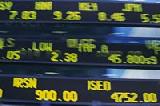
 |
|
| Financial Terms | |
| Tradable |
|
Information about financial, finance, business, accounting, payroll, inventory, investment, money, inventory control, stock trading, financial advisor, tax advisor, credit.
Main Page: investment, inventory, tax advisor, financial advisor, money, stock trading, payroll, inventory control, |
Definition of Tradable
TradableGood or service that is capable of being traded.
Related Terms:Non-tradablesRefer to goods and services produced and consumed domestically that are not close FloatThe number of shares that are actively tradable in the market, excluding shares that are held by officers All or noneRequirement that none of an order be executed unless all of it can be executed at the specified price. All-or-none underwritingAn arrangement whereby a security issue is canceled if the underwriter is unable Availability floatChecks deposited by a company that have not yet been cleared. Bank collection floatThe time that elapses between when a check is deposited into a bank account and when the funds are available to the depositor, during which period the bank is collecting payment from the payer's bank. Collection floatThe negative float that is created between the time when you deposit a check in your account  Corporate processing floatThe time that elapses between receipt of payment from a customer and the Dirty floatA system of floating exchange rates in which the government occasionally intervenes to change Disbursement floatA decrease in book cash but no immediate change in bank cash, generated by checks Floaterfloating rate bond. Floating exchange rateA country's decision to allow its currency value to freely change. The currency is not Floating lienGeneral lien against a company's assets or against a particular class of assets. Floating supplyThe amount of securities believed to be available for immediate purchase, that is, in the Floating-rate contractA guaranteed investment contract where the credit rating is tied to some variable Floating-rate note (FRN)Note whose interest payment varies with short-term interest rates.  Floating-rate payerIn an interest rate swap, the counterparty who pays a rate based on a reference rate, Floating-rate preferredPreferred stock paying dividends that vary with short-term interest rates. Free floatAn exchange rate system characterized by the absence of government intervention. Also known as Inverse floating rate noteA variable rate security whose coupon rate increases as a benchmark interest rate declines. In-house processing floatRefers to the time it takes the receiver of a check to process the payment and Mail floatRefers to the part of the collection and disbursement process where checks are trapped in the postal system. Managed floatAlso known as "dirty" float, this is a system of floating exchange rates with central bank Monetary / non-monetary methodUnder this translation method, monetary items (e.g. cash, accounts Net floatSum of disbursement float and collection float. Non-cumulative preferred stockPreferred stock whose holders must forgo dividend payments when the Non-financial servicesInclude such things as freight, insurance, passenger services, and travel. Non-insured plansDefined benefit pension plans that are not guaranteed by life insurance products. Related: Non-parallel shift in the yield curveA shift in the yield curve in which yields do not change by the same Non-reproducible assetsA tangible asset with unique physical properties, like a parcel of land, a mine, or a Noncash chargeA cost, such as depreciation, depletion, and amortization, that does not involve any cash outflow. Noncompetitive bidIn a Treasury auction, bidding for a specific amount of securities at the price, whatever it Nondiversifiability of human capitalThe difficulty of diversifying one's human capital (the unique Nondiversifiable riskRisk that cannot be eliminated by diversification. Nonmarketed claimsClaims that cannot be easily bought and sold in the financial markets, such as those of NonrecourseWithout recourse, as in a non-recourse lease. NonredeemableNot permitted, under the terms of indenture, to be redeemed. NonrefundableNot permitted, under the terms of indenture, to be refundable. Nonsystematic risknonmarket or firm-specific risk factors that can be eliminated by diversification. Also Payment floatCompany-written checks that have not yet cleared. Positive floatSee:float. Non-production overheadA general term referring to period costs, such as selling, administration and financial expenses. noncontrollable variancethe fixed overhead volume variance; non-negativity constrainta restriction in a linear programming non-value-added (NVA) activityan activity that increases the time spent on a product or service but that does not increase its worth or value to the customer availability floatChecks already deposited that have not yet been cleared. floating-rate securitySecurity paying dividends or interest that vary with short-term interest rates. net floatDifference between payment float and availability float. payment floatChecks written by a company that have not yet cleared. Clean FloatA flexible exchange rate system in which the government does not intervene. Dirty FloatA flexible exchange rate system in which the government intervenes. Floating Exchange RateSee flexible exchange rate. Nonqualified Retirement PlanA pension plan that does not follow ERISA and Nonqualified Stock OptionA stock option not given any favorable tax treatment Nonmarketable SecurityA debt or equity security for which there is no posted price or bidand- Nonrecurring ItemsRevenues or gains and expenses or losses that are not expected to recur Nonconforming materialAny inventory item that does not match its original design Nonsignificant part numberAn identifying number assigned to a part that conveys Non-Smoker DiscountIn October 1996 it was announced in the international news that scientists had finally located the link between cigarette smoking and lung cancer. In the early 1980's, some Canadian Life Insurance Companies had already started recognizing that non-smokers had a better life expectancy than smokers so commenced offering premium discounts for life insurance to new applicants who have been non-smokers for at least 12 months before applying for coverage. Today, most life insurance companies offer these discounts. Non-Medical LimitThis is the maximum value of a policy that an insurance company will issue without the applicant taking a medical examination, although medical questions are invariably asked during the application process. When a non-medical issue is made through group insurance, in most cases, medical data is not requested at all. Floating ChargeCharge or assignment on a company's total assets as security for a loan on total assets without specifying specific assets. Floating Interest RateA rate that fluctuates with general market condition. NSF (non-sufficient funds)This appears on your statement if there are insufficient funds in your account to cover a cheque that you have written or a pre-authorized payment that you have already arranged. You will be charged a service fee for non-sufficient funds. Non-participating PolicyA type of insurance policy or annuity in which the owner does not receive dividends. Related to : financial, finance, business, accounting, payroll, inventory, investment, money, inventory control, stock trading, financial advisor, tax advisor, credit. |